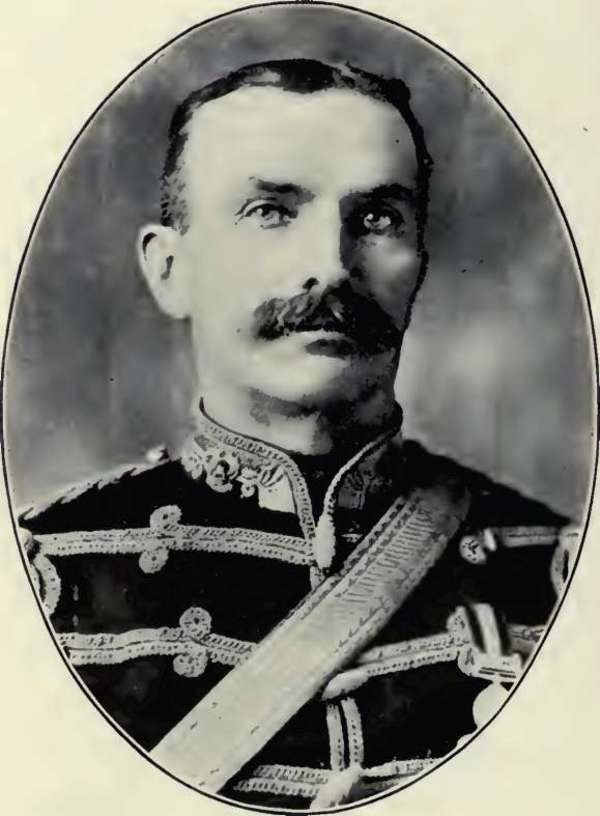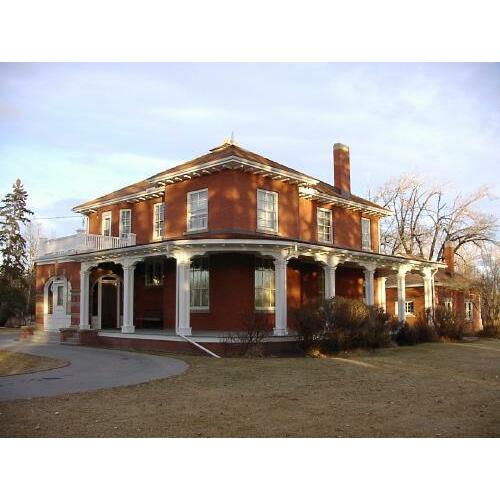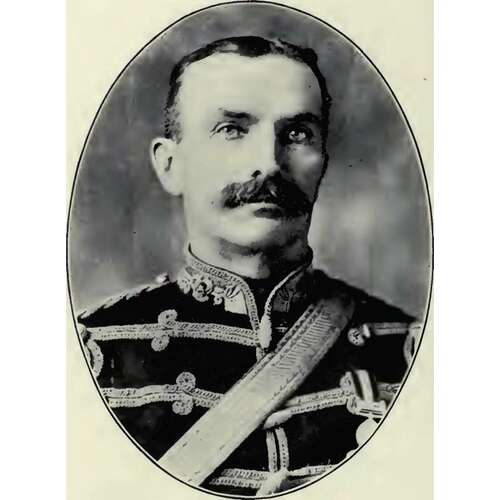
Source: Link
WALKER, JAMES, farmer, militia officer, NWMP officer, ranch manager, businessman, and army officer; b. 14 April 1846 near Carluke, Upper Canada, son of James Walker and Margaret Allison; m. 17 May 1876 Euphemia (Effie) Davidson Quarrie in Galt (Cambridge), Ont., and they had a son; d. 31 March 1936 in Calgary.
A native of Ancaster Township, southwest of Hamilton, James Walker was the fifth of the seven children of Scottish-born Presbyterian parents. He learned the farming business from his father, an expert horseman and ploughman; by age 18 he had assumed the responsibility of running the home farm. He also inherited his father’s interest in the military. In 1866 he signed up for a three-month training course in Toronto conducted by the 2nd Battalion of the 17th Regiment, an exercise he repeated four years later. His first taste of active militia service came in 1871 during the second Fenian campaign [see John O’Neill*], when he joined the 37th (Haldimand) Battalion of Infantry.
In 1873 Walker, now a major, took gunnery instruction in Kingston, Ont., where he earned the admiration of commanding officer Lieutenant-Colonel George Arthur French*. As first commissioner of the newly formed North-West Mounted Police, French persuaded him to join the force with the rank of sub-inspector. On his enlistment, Walker’s bearing turned west, though he would return to Ontario at least once, to marry the daughter of a Galt saddler.
Recognizing Walker’s ability to handle both men and horses, French enlisted his aid in recruitment, and placed him in charge of transporting over 200 horses from Toronto to Dufferin, Man. Walker’s service was varied and eventful. He took part in the famous Long March west in 1874, and established the post at Battleford (Sask.) in 1876. Described as a giant of a man, he epitomized the vigour so often associated with the early personnel of the NWMP. For instance, during the march he pursued a stampede of horses from Dufferin, riding 120 miles in 24 hours and driving them back virtually unaided, and in the winter of 1874–75 he chased a deserter for 60 miles before returning him to camp tied to a horse. In the ensuing years he was instrumental in keeping the peace during treaty payments to Indians. On two occasions he averted potential violence by dealing firmly with disgruntled chiefs, Kamīyistowesit* at Duck Lake (Sask.) in 1877 and Mistahimaskwa* at Sounding Lake (Alta) in 1878. At other times his independence and commonsensical approach to native issues incurred official disfavour in Ottawa. He was criticized for putting a stockade around the post at Battleford, a move that would prove its worth during the North-West uprising of 1885 [see Pītikwahanapiwīyin*], and for advancing food supplies to hungry natives before the authorized rations had arrived.
Walker left the NWMP in 1881 to take up the position of operations manager on Senator Matthew Henry Cochrane*’s newly organized ranch in the Alberta foothills. Recommended by Edgar Dewdney*, the lieutenant governor of the North-West Territories, whom he had known from treaty-payment days, Walker had probably made up his mind following a meeting with Sir John A. Macdonald*, whose ministerial responsibilities included the NWMP. The work, however, was less than rewarding. In 1881 and again in 1882 Walker purchased cattle in Montana and drove them to the Cochrane leasehold only to see the herds fall victim to extreme cold and starvation. He left Cochrane’s employ in late 1882 after buying the ranch-owned sawmill. He brought it to Fort Calgary [see John Glenn*], where he had earlier filed on land along the Bow River, and began a ranching and farming operation in addition to milling.
For the next three decades Walker’s contributions to the growth of early Calgary were incalculable. As an early proponent of mixed farming, he was one of the first serious agricultural experimentalists in the area. His Bow River Saw and Planing Mills was a major supplier of construction materials for the developing town, including its new NWMP barracks in 1883. A jp and notary public, he chaired the committee that pressed for town incorporation in 1884. The following year he was named first president of the Board of Trade, was the driving force behind the establishment of Calgary’s first school district, organized a home guard to protect the town during the North-West uprising, and installed the town’s first telephones, between his office and his mill two miles away. In 1886 Walker, the founding president of the Calgary District Agricultural Society, was instrumental in securing federal land for exhibition purposes. The first local supply of natural gas was discovered on his property in 1908, and he made use of it to heat his residence. Walker organized the Boy Scout Association of Alberta, served as its president, and played a formative role in the local cadet movement. In 1905 he had established the city’s first militia unit, the 15th Light Horse, and been appointed its lieutenant-colonel. For several years he was president of the Alberta Provincial Rifle Association.
At the age of 70, during World War I, the indomitable Walker was made a captain in the 238th Forestry Battalion and went overseas. As well as inspecting and making recommendations on forest resources in England and Scotland, for the supply of wood to the forces, he commanded a company in Cumberland. In one hectic week his men cut an unprecedented 36,400 feet of lumber per day. He was promoted major in 1917 and stayed in Britain until 1919.
James Walker remained active to the end. Following his return to Calgary, he engaged in a variety of businesses. With his son, William James Selby, he ran an investment, insurance, and real-estate agency. As well, in the 1920s he was president or vice-president of three oil companies. He also maintained his military connections, being honorary colonel on the adjutant-general’s cadet committee in Ottawa and, from 1911, honorary lieutenant-colonel of the 23rd Alberta Rangers. His sudden death in 1936, just before his 90th birthday, marked the passing of the last officer from the historic Long March of 1874 and the longest-serving militia officer in the country.
With his fine physique, military bearing, and practical intelligence, Walker was in many ways the quintessential frontiersman. He was a man of daring and courage, a natural leader who gravitated to what had to be done. In early Calgary he represented an organizational focus for the building of fledgling institutions. To the hundreds who knew and respected him, he was “Major” and later “Colonel” Walker. To the natives with whom he dealt, he was Pee-tee-quack-kee – “the eagle that protects.” In 1975 he was named Calgary’s “Citizen of the Century,” a title well earned and well deserved.
James Walker is the author of “My life in the North-West Mounted Police,” Alberta Hist. Rev. (Edmonton), 8 (1960), no.1: 1–14.
AO, RG 80-5-0-61, no.11119. GA, M 986, M 1270, M 1271, M 1536, M 2471, M 2828, M 3165, M 3292, M 5877, M 6898. Calgary Herald, 31 March 1936. Dominion annual reg., 1880/81: 382; 1883: 295. Max and H. MacE. Foran, Calgary, Canada’s frontier metropolis: an illustrated history, intro. J. W. G. MacEwan (n.p., 1982). [J. W.] G. MacEwan, Colonel James Walker: man of the western frontier (Saskatoon, 1989). Who’s who and why, 1919/20. Who’s who in Canada, 1925/26.
Cite This Article
Max Foran, “WALKER, JAMES,” in Dictionary of Canadian Biography, vol. 16, University of Toronto/Université Laval, 2003–, accessed December 19, 2025, https://www.biographi.ca/en/bio/walker_james_16E.html.
The citation above shows the format for footnotes and endnotes according to the Chicago manual of style (16th edition). Information to be used in other citation formats:
| Permalink: | https://www.biographi.ca/en/bio/walker_james_16E.html |
| Author of Article: | Max Foran |
| Title of Article: | WALKER, JAMES |
| Publication Name: | Dictionary of Canadian Biography, vol. 16 |
| Publisher: | University of Toronto/Université Laval |
| Year of publication: | 2014 |
| Year of revision: | 2014 |
| Access Date: | December 19, 2025 |




